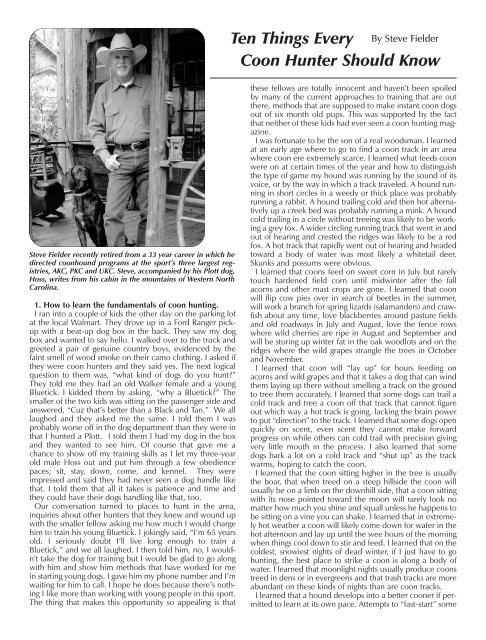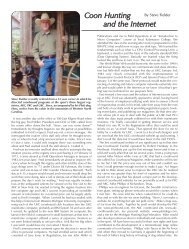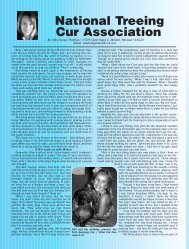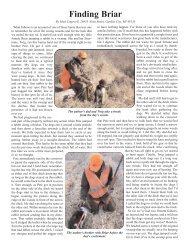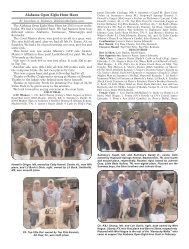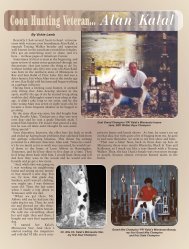Ten Things Every Coon Hunter Should Know - Huntinghoundsmen ...
Ten Things Every Coon Hunter Should Know - Huntinghoundsmen ...
Ten Things Every Coon Hunter Should Know - Huntinghoundsmen ...
Create successful ePaper yourself
Turn your PDF publications into a flip-book with our unique Google optimized e-Paper software.
<strong>Ten</strong> <strong>Things</strong> <strong>Every</strong> By Steve Fielder<strong>Coon</strong> <strong>Hunter</strong> <strong>Should</strong> <strong>Know</strong>Steve Fielder recently retired from a 33 year career in which hedirected coonhound programs at the sport’s three largest registries,AKC, PKC and UKC. Steve, accompanied by his Plott dog,Hoss, writes from his cabin in the mountains of Western NorthCarolina.1. How to learn the fundamentals of coon hunting.I ran into a couple of kids the other day on the parking lotat the local Walmart. They drove up in a Ford Ranger pickupwith a beat-up dog box in the back. They saw my dogbox and wanted to say hello. I walked over to the truck andgreeted a pair of genuine country boys, evidenced by thefaint smell of wood smoke on their camo clothing. I asked ifthey were coon hunters and they said yes. The next logicalquestion to them was, “what kind of dogs do you hunt?”They told me they had an old Walker female and a youngBluetick. I kidded them by asking, “why a Bluetick?” Thesmaller of the two kids was sitting on the passenger side andanswered, “Cuz that’s better than a Black and Tan.” We alllaughed and they asked me the same. I told them I wasprobably worse off in the dog department than they were inthat I hunted a Plott. I told them I had my dog in the boxand they wanted to see him. Of course that gave me achance to show off my training skills as I let my three-yearold male Hoss out and put him through a few obediencepaces; sit, stay, down, come, and kennel. They wereimpressed and said they had never seen a dog handle likethat. I told them that all it takes is patience and time andthey could have their dogs handling like that, too.Our conversation turned to places to hunt in the area,inquiries about other hunters that they knew and wound upwith the smaller fellow asking me how much I would chargehim to train his young Bluetick. I jokingly said, “I’m 65 yearsold. I seriously doubt I’ll live long enough to train aBluetick,” and we all laughed. I then told him, no, I wouldn’ttake the dog for training but I would be glad to go alongwith him and show him methods that have worked for mein starting young dogs. I gave him my phone number and I’mwaiting for him to call. I hope he does because there’s nothingI like more than working with young people in this sport.The thing that makes this opportunity so appealing is thatthese fellows are totally innocent and haven’t been spoiledby many of the current approaches to training that are outthere, methods that are supposed to make instant coon dogsout of six month old pups. This was supported by the factthat neither of these kids had ever seen a coon hunting magazine.I was fortunate to be the son of a real woodsman. I learnedat an early age where to go to find a coon track in an areawhere coon ere extremely scarce. I learned what feeds coonwere on at certain times of the year and how to distinguishthe type of game my hound was running by the sound of itsvoice, or by the way in which a track traveled. A hound runningin short circles in a weedy or thick place was probablyrunning a rabbit. A hound trailing cold and then hot alternativelyup a creek bed was probably running a mink. A houndcold trailing in a circle without treeing was likely to be workinga grey fox. A wider circling running track that went in andout of hearing and crested the ridges was likely to be a redfox. A hot track that rapidly went out of hearing and headedtoward a body of water was most likely a whitetail deer.Skunks and possums were obvious.I learned that coons feed on sweet corn in July but rarelytouch hardened field corn until midwinter after the fallacorns and other mast crops are gone. I learned that coonwill flip cow pies over in search of beetles in the summer,will work a branch for spring lizards (salamanders) and crawfishabout any time, love blackberries around pasture fieldsand old roadways in July and August, love the fence rowswhere wild cherries are ripe in August and September andwill be storing up winter fat in the oak woodlots and on theridges where the wild grapes strangle the trees in Octoberand November.I learned that coon will “lay up” for hours feeding onacorns and wild grapes and that it takes a dog that can windthem laying up there without smelling a track on the groundto tree them accurately. I learned that some dogs can trail acold track and tree a coon off that track that cannot figureout which way a hot track is going, lacking the brain powerto put “direction” to the track. I learned that some dogs openquickly on scent, even scent they cannot make forwardprogress on while others can cold trail with precision givingvery little mouth in the process. I also learned that somedogs bark a lot on a cold track and “shut up” as the trackwarms, hoping to catch the coon.I learned that the coon sitting higher in the tree is usuallythe boar, that when treed on a steep hillside the coon willusually be on a limb on the downhill side, that a coon sittingwith its nose pointed toward the moon will rarely look nomatter how much you shine and squall unless he happens tobe sitting on a vine you can shake. I learned that in extremelyhot weather a coon will likely come down for water in thehot afternoon and lay up until the wee hours of the morningwhen things cool down to stir and feed. I learned that on thecoldest, snowiest nights of dead winter, if I just have to gohunting, the best place to strike a coon is along a body ofwater. I learned that moonlight nights usually produce coonstreed in dens or in evergreens and that trash tracks are moreabundant on these kinds of nights than are coon tracks.I learned that a hound develops into a better cooner if permittedto learn at its own pace. Attempts to “fast-start” some
hounds fail and those pups are culled when a little time andpatience, exposing the pup to opportunities continuallywithout “pushing” often results in a better hound. Dogs arelike kids. The ones that are permitted opportunities continuallybut are allowed to develop a love for learning usuallymake better students in the long run.Stud dog ads are largely responsible for creating the needfor pup buyers to push a pup beyond its ability to processthe training. If he’s not a six-month wonder like the otherpups in the ads, he’s a loser. If nothing else in this articleclicks, please take this one to heart. Remember the Ernestand Julio Gallo commercial – “We will sell no wine before itstime?” Apply that philosophy to pup training. Don’t cull thatpup until you are sure he or she is mature enough to processthe opportunities you are presenting them.2. How to find places to hunt.Most coon hunters will agree, the most severe threat to thesport of coon hunting is the decline in places to safely runour hounds. The current economic downturn has somewhatstemmed the tide of building that was the case a few yearsago. Urban sprawl is taking a breather for now and with thedecline in building the demand for hardwood timber issomewhat diminished. A downside to the poor economy forcoon hunters is that land owners, including the big timbercompanies with hundreds of thousands of acres across thesouth, and small farmers alike are looking for tax breaks.They have learned they can offset their tax burdens by leasingthe land. Leases usually involve deer and turkey huntersthat generally hold dog hunters in disdain. Combine thatwith hunting seasons that exclude dog hunting, likeMississippi’s spring turkey season for example and you seethat finding opportunities to run dogs can be a challenge.Many states now have recreational trespass laws thatrequire written permission. Many landowners will give permissionto hunt but don’t want to put it into writing for fearof repercussions should someone get hurt on their land.When I lived in Michigan I devised a written permissionstatement and carried copies in my truck. When Iapproached a land owner about hunting I showed them theform that stated that I would not hold them responsible forinjury or death incurred while on their property and that ifmy dogs or I were responsible for damage to his or her propertywhile engaged in hunting or training dogs, I would befully responsible. I signed it along with their signature allowingme to hunt their lands. I never had a landowner refuseto sign the form after I had signed it in their presence.Your demeanor when asking for permission has a lot to dowith the answer you get. I usually went on a Sunday afternoon.If possible I took my son or my wife with me. Iwashed my truck before I went. I put on presentable clothes.I wanted to present a wholesome look. If I appeared with athree day growth of beard, dirty jeans and t-shirt and drovea vehicle covered in mud the landowner was likely to drawmany conclusions, one of which could indicate that I hadbeen up all weekend digging ruts in some farmer’s field withmy 4x4. I usually make the point that my dogs don’t run livestockand chase deer and that I have the means, via the GPSunit and the Tri-tronics to control them at all times. I ask ifit’s okay for me to come at any time during the night orwould the land owner prefer early evening hours before hegoes to bed. I assure the land owner that I will not climb hisfences except when absolutely necessary and then only atthe post, I’ll close all gates behind me that were closedbefore I arrived, that I won’t drive across his fields and that Iwill not leave anything behind me that was not there whenI arrived. I have to continually remind myself that I am aguest and that I must behave on the landowner’s propertyjust as I would behave if invited into his home. Learn this lessonand develop this attitude and you will find that mostfarmers will let you hunt.3. How to select the right kind of gearWe’ve often joked about the guy at the hunts with the$40,000 truck, the $1000 tracking system, the $800 dogbox, the $500 shock collar, the $400 light, the $200 bootsand the two-dollar dog. But there’s no denying it, the equipmentyou choose will not only enhance your enjoyment ofthe sport but will also improve your odds of having a successfulhunt, whether for pleasure or in competition. Here ismy list of fundamental gear items that I have with me onevery hunt:First, you need a quality light source. I am absolutely soldon the new, lightweight LED lights that are on the markettoday. In my view there is no longer any need to carry theweight of a battery box or pack on the belt. Secondly, inorder to have a comfortable hunt, a good pair of well-fittingrubber boots with water resistant chaps properly sewn to theleg of the boots is essential for wading briars and nettles andfor crossing creeks. John Wick once said, “When your feetget wet, the fun’s over,” and I agree. Thirdly you will wantto invest in a Garmin GPS-enhanced tracking system andlearn to use it. It will help you recover your dog, keep thedog out of harm’s way and take you to the truck at the endof the hunt. If you are a young hunter, electronic gizmosoffer no problem to you and you will catch onto the use ofthe Garmin quickly. If you are a geezer like me, ask one ofthe kids at the club to show you how. Next in order is a Tri-Tronics Trashbreaker trainer. Read all you can about the useof this trainer and never turn your hound loose without it. Itsapplications are too many to list here but trust me and don’tleave home without it. Of course you will need a 4x4 pickupand a dog box to round out your list of essentials. I wouldadd a good quality coon squaller such as the Zepp and agood pocket knife. For some of you, a stop at the cornerstore for some chew is also an essential. I’ll pass on that,thank you very much.4. How to buy a coonhound without getting burned.<strong>Coon</strong> hunters are human and humans by their very naturewill lie. I have a friend that teaches in public schools. I haveheard her tell of watching kindergartners doing some type ofnegative behavior and when asked, “Johnny, why did you dothat?” Little Johnny says, “I didn’t do it.” The teacher replies,“I was standing here watching you do it,” to which LittleJohnny says, “It wasn’t me.”If there’s one thing that brings the urge to prevaricate to thesurface in the human race it’s this thing we call coon hunting.<strong>Coon</strong> hunters, like fisherman can’t resist the temptationto lie. Do you think that’s harsh? Consider this scenario, oneI’ve witnessed many times over the years.Time out has been called or the hunt is over and a dog hasnot been handled. The owner employs the tracking deviceand leaves the cast to retrieve his or her dog. Upon return,what does the handler say? You go to the head of the classif you get this one right and get to wear the dunce cap if youmiss it. I’ll bet you a dollar against a donut that the handlersays, “He was treed and had the coon.” I have never hearda handler in that situation say, “He was treed slick.” Whydoes the handler think he has to lie? Unless lying is thathunter’s best friend, the answer lies in one word; pride.When we put our nameplates on these coonhounds theybecome extensions of ourselves. An average dog becomes a“number one coon dog” because to admit anything lesswould be to admit that we either don’t know how to train acoon dog or we were dumb enough to buy an “average” dogwhen the world knows we hunt nothing but the best. This
type of lying is generally harmless to our fellow hunters (I’mnot going to venture my thoughts on what the Lord thinksabout it) unless we employ it to help us sell the dog to theunsuspecting buyer. This is where lying becomes larcenyand unfortunately for us, there are a lot of folks out therethat are making a living by it.There’s only two ways to keep from getting burned on adog deal. The first is to go and hunt with the dog, not onenight but as many nights and under as many different typesof conditions as you can. The second is, if you do not knowthe owner of the dog personally, and have not had previousdealings with the owner of the dog to the point that youknow that you know that you know that man to be absolutelyhonest, don’t take his word for it. In case you missed that,I’m saying: “Don’t take anyone’s word as to the ability of adog unless it’s a guy you would send to Vegas with yourcredit car andd the deed to your home.” Get the point?Why? Because when it comes to dogs most coon huntersjust can’t help but lie. If this offends you, you either areabsolutely honest or the truth hurts.And as a footnote to this item, a new coon hunter shouldbuy a veteran cooner as his or her first dog. You will be surprisedin this world of “pups” how many good coonhounds,many of them with Grand Nite Champion titles are for saleonce they graduate out of the pup-hunt stage of their lives.Buying an older, finished coonhound will serve to teach theyoung hunter more about coon hunting that all the articleslike this in the world and they represent the best buys in thecoonhound market. Then, once you have the “feel” for thesport, find a good-blooded pup of your liking and train itwith your veteran cooner. That’s probably the best adviceyou will read in this article this month.5. How to breed, buy and train a coonhound pup<strong>Coon</strong>hound magazines are full of stud ads and all proclaimto be the best since sliced bread in terms of “reproducing”themselves. The rule of thumb when looking at a prospectivestud is this: “You don’t get the stud, you get what he produces.”That’s true but to put all your eggs in the stud dog’sbasket when deciding to buy a pup is just half the equation.Any prospective pup buyer should remember this. There areno 100% guarantees in terms of what a cross will produceand there are no absolute “proven crosses.” Yes, there arecrosses that have produced outstanding offspring but there isno guarantee that when that sire and dam are bred againthat the pups will turn out like the previous ones just as thereis no guarantee that the title the dog holds indicates the typeof coonhound you will want to hunt and feed. The dam ofthe pup is vitally important, too. Here is my advice to anyonelooking to buy a pup that will hopefully be a goodprospect and with proper handling and training, willbecome a winner or a pleasure dog you will be proud tohunt.Look for a “family” of dogs that carry the traits that you preferin a coonhound. Almost all purebred coonhound pups oftoday will tree. A well bred pup should possess the treeinginstinct as inherently as the desire to eat, drink, sleep andpoop. Most well-bred pups will tree before they run track.Once I’ve found the family of dogs I like I would try to get apup from a 12.5% inbred cross from within that family;uncle to niece, aunt to nephew, grandsire to granddaughter,granddam to grandson, or half-brother to half-sister crossesare key. I would avoid family breeding of the 25% varietymeaning sire to daughter, mother to son or full brother to fullsister matings. Lloyd Brackett, called Mr. German Shepherdfor his success with that breed, selected his stud dog andthen bred five daughters of that stud to him, daughters thatmost resembled the stud, and produced astounding resultsin the show ring. I’m not advocating that kind of intensefamily breeding because most of us don’t have the stomachto cull when inbreeding brings faults to the surface as it surelywill.Let’s say there’s a stud out there and you’ve gone out andhunted with him. You like his looks, his genetic backgroundand the way he gets in there and gets the job done, finishingwith that classic loud tree bark you have been looking for. Ofcourse he needs to have the coon. The next thing you needto do is to try to find a granddaughter or niece to that dogthat looks, acts, and hunts as much like that stud as you can.If the stud owner doesn’t have that bitch, then your job is toeither persuade the owner of that bitch to breed to yourchosen stud or to buy the female and breed her yourself.That’s the quickest route to getting the type of pups that youwant with a word of caution repeated from the open wordsof this item. There are no guarantees and there are no 100%proven crosses. I have witnessed, on several occasionsrepeat matings that produced pups that were nothing likeearlier matings of the same cross. I have also witnessed someastounding results when breeding coonhounds in this way.Like the young hunters mentioned in the first item in thispiece, many of us lack the knowledge to train a coonhoundpup. For me, training means teaching the pup basic obedience,house breaking and displaying the best of mannerswhen with people, other dogs and livestock. I look to natureto provide and develop the basic elements that a coonhoundrequires to become a top hound. My job is simply toexpose the pup to learning opportunities that will allow hisbreeding to surface. Here are some basics:a. Expose a pup to a caged coon once or twice just to lethim know that’s what you are after. Tie the pup back, placethe coon out of his reach and use another dog to bark at thecage. If the pup shows no interest, drag the cage back andforth just beyond his reach. Never lead a pup up to a cagedcoon and try to force it to react to the coon.b. Once the pup is barking at the coon, take it away. Thenext step is for another training session. Take the caged coonand place it in an open field. Go back and get the pup andturn it loose, walking in the direction of the cage. When thepup finds the cage and barks, go to it and tie the pup back.I use one of the screw-in stakes for this purpose. Turn thecoon loose toward the woods, preferably 50 to 100 yardsdistant. Let the pup watch the coon until it is out of sight.Turn the pup loose. It will sight-chase the coon in the directionit went but when it gets to the woods it will have to useits nose to find the coon. Usually the coon will go up the firsttree it comes to and the pup’s natural treeing instincts willsurface. I would do this a couple of times max, each in a separatesession and then take the pup to the woods at nightwhere it will encounter wild coon scent.c. Too much sight work on caged or “hang-up” coons,either on the ground or in a tree is detrimental to producinga coon dog that will locate and tree off scent. Many huntersshoot a coon and drag it for the pup, hanging it up on a lowhanginglimb. If you do this, do it sparingly, once or twiceand that’s it. You are only trying to trigger the pup’s instincts.If you persist, you will produce a dog that wants to tree bysight.Of course there are many other elements to training acoonhound pup, most of which involve keeping that pup inthe woods once he starts but that’s a whole book in itself.6. How to develop a lifetime network of coon huntingfriendsI once talked to a fellow that told me he had worked hardfor everything he had attained in this sport and that no oneever gave him anything. I replied that I was very proud of the
dog and beyond that, knowing just how many points youneed to win the cast. Good handlers know that and unlikeBubba, who at the all-you-can-eat-for-a dollar buffet, ordersthree dollars’ worth, they claim only the number of pointsthey need to win or to protect the score they have.Gary Hern, who has won World Championships in tworegistries told a young hunter in Michigan, “<strong>Every</strong>one in thecast knows your dog treed first but that doesn’t mean youhave to take every first tree.” That’s good advice. Withoutwriting a book on handling I’ll simply hope that you rememberthese points:a. <strong>Know</strong> the dog you are hunting inside and out. This isonly accomplished by hunting that dog several nights, weekin and week out.b. Strike your dog on or before the third bark when it isopening honestly. Don’t be the guy that strikes his dog off thechain on a babble. It will come back to bite you.c. Don’t pitch you dog on the tree. Recognize your dog’slocate and tree him when you are reasonably sure he willstay. You don’t have to be first. Sometimes, on a questionabletree it’s better to take last tree to simply protect yourstrike points from being minused if the coon is seen.d. Be aware of the scores of the other dogs in your cast. Ifyou are safely ahead, don’t make foolish calls. John Wickimpressed me with his talk to the young hunters at the AKCYouth World Championship when he asked them to repeatthe most important thing they should have learned fromwhat he told them; “Don’t put minus points on your dog thatit doesn’t deserve.” That’s good advice for any handler.9. How to maintain the health you need to participate inthis sport.Although vigorous at times, coon hunting does not providethe degree of cardio-vascular workout activity that is essentialto good health and a long life with the sport. I am a perfectexample of that. I have never weighed more than 165pounds and weigh about five pounds less than that now. Ihave never been a smoker, don’t drink alcohol other than anoccasional glass of wine with dinner and rarely eat fattyfoods. Nonetheless, I suffered a heart attack in 2006 whileparticipating in a UKC Nite Hunt in North Carolina thatresulted in double bypass surgery at Duke UniversityHospital. The villain was my genetic history of high cholesteroland triglycerides combined with too many hours sittingin front of a computer monitor at work. I was one of thelucky ones in that I did not die in the woods but the coonhunting history books are full of the names of guys that didjust that.If you are going to coon hunt, and you are not in shape,you are flirting with disaster. It is essential that you maintaina steady regimen of proper diet, daily exercise that buildsand maintains your heart rate and an annual checkup withyour family doctor. Walking to trees on an average coonhunt will not keep you in shape regardless of where youhunt. Consider the condition of your health if you want tocontinue to enjoy the sport, and your family and friends, intoyour retirement years.10. How to avoid the pitfalls that many coon huntersfall intoIf you have chosen coon hunting as your chief recreationalactivity you have not chosen an easy sport and that’s evidencedon many levels. It’s a given that you will lose lots ofsleep, your patience and your bank account will be sorelytried and at the end of the day, or night as the case may be,you will wonder how in the world you of all people got intothis crazy sport. You are not alone.One to the chief pitfalls that young hunters make is that thelure of the woods at dark-thirty becomes all-consuming tothe detriment of things that should occupy a higher spot ontheir priority lists. Many are the tales of once-married coonhunters that left a lonely girl at home too many nightsbecause come hell or high water, when it got dark they weregoing hunting. I once sat in a breed association meeting inIllinois on a Saturday afternoon with a well-known hunterfrom Ohio that has since passed away. He said, “Steve, I’min big trouble. My daughter is getting married tonight inOhio and I’m not going to be there.” I’m still shaking myhead at that one but with some coon hunters, that’s the wayit is. Don’t be that guy either.When we were raising my son, travel was an integral partof my job at UKC. I missed birthdays, important ball gamesand family gatherings because of the weekend travel. WhenI was home I always put family matters ahead of hunting,always. If the family wanted to do something on the weekendof a hunting trip I planned, I cancelled the trip. Familywas vitally more important to me than hunting. Anyone whois thinking otherwise needs the proverbial check-up from theneck up.Secondly, don’t make promises you can’t keep. It bothersme that coon hunters seem to get a pass when it comes tocommitment. Just ask any hunt director on the night of thebig hunt when it’s time to put the guides on the scorecards.Sure, clubs can be demanding, especially when they schedulebig hunts, but if you tell someone you will be there, barringany emergency, you should honor that commitment.Otherwise you will be labeled a liar. Harsh, maybe but that’sthe way I see it.If you tell someone you will buy a pup and whether theyrequire you to send a deposit or not, don’t blow it off whenyou change your mind. You told them you would take thepup, now take it. If you tell someone you will be there at acertain time, be there. I have been guilty of this. I’ve alwaysseemed to have several balls in the air at all times and oftenhave been 15 minutes or more late in meeting a huntingbuddy for the night’s hunt. Now, if I’m going to be late, Icall. It’s not fair to use someone else’s time because I didn’tplan properly.If you put enough faith in someone’s stud dog or the litterof pups they are offering for sale to purchase one, don’t bea pansy and ask for a guarantee. You are the one that madethe decision to buy the pup and barring any obvious healthissues that were present in the pup when you bought it youshould assume full responsibility for your decision in buyingthe pup. God only knows whether that pup will turn out. Ifyou made the decision to buy, that’s your decision and youneed to live with it. Some will disagree with me. I had onefellow in Texas that bought a pup from me tell me that hehad bought 30 purebred coonhound pups and never hadone that started. He wanted me to refund his purchase pricebecause the puppy was aggressive in the food dish. I toldhim I would but he would have to return the pup in goodhealth. I never heard from him again. I wonder what he didwith all those pups?Don’t be a slob hunter. Don’t hunt where you don’t havepermission. Don’t leave gates open and litter behind. Don’tcut muddy ruts in the farmer’s field. Don’t shine your headlightsinto a farmhouse window when you turn in the drive.Don’t kill coon out of season. Don’t kill every coon out of atree. Don’t bad-mouth your hunting buddy’s dog. Don’tbrag on your dog to the point of making everyone at theclubhouse nauseous. Better yet, just simply follow theGolden Rule and that will help you to avoid all the pitfalls ofthis sport that may come your way. Thanks for reading.


